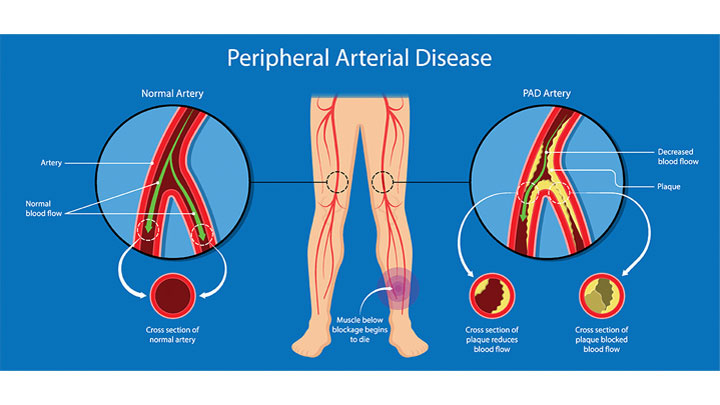Called Peripheral Artery Disease (PAD), When Advanced, It’s the Leading Cause of Amputations Worldwide
and Results in High Rates of Fatal and Non-Fatal Cardiovascular Events2,3
Peripheral artery disease (PAD) is a common chronic circulatory condition that often goes undiagnosed and undertreated.1 In fact, PAD impacts an estimated 20 million Americans,4 yet only 8.5 million are diagnosed.5 If left untreated, PAD can increase the risk of serious health outcomes such as heart attack, stroke, acute limb ischemia or even a lower limb amputation.6 Despite being largely preventable, amputations can be a devastating complication of PAD associated with high mortality.3
Earlier this year, the American Heart Association (AHA) issued a charge to reduce nontraumatic lower-extremity amputations by 20% by 2030. Despite a steady decline in the rate of amputations in two previous decades, the amputation rate among patients with peripheral artery disease (PAD) and diabetes – the patient group among the highest risk for lower extremity amputations – increased by 50% over a span of only six years (from 2009 to 2015) and the rate of amputations continues to rise in the U.S.3
Further, significant health disparities exist in the prevalence, diagnosis and care of patients with PAD. For example, Black Americans – who have a higher prevalence of asymptomatic PAD, less access to quality vascular care,6 and are at risk for delays in care8 – are up to 4x more likely to have an amputation as a result of PAD compared to White Americans.3
Serious outcomes, including lower-extremity amputation, cannot be effectively prevented if its leading cause, PAD, is not diagnosed and managed.6 By elevating PAD awareness and increasing access to screening and treatment, both patients and physicians can be empowered to better understand the symptoms of PAD, seek care at the optimal time, and have the right conversations at their visits to help reduce the chance of serious outcomes.5
Dr. Geoffrey Barnes, cardiologist, vascular medicine specialist, and faculty member at the University of Michigan Frankel Cardiovascular Center and Institute for Healthcare Policy and Innovation, to discuss the importance of early identification, intervention and management of PAD.
Interview courtesy: Janssen Pharmaceuticals, Inc.
References
1 Afzal N, Sohn S, Scott CG, Liu H, Kullo IJ, Arruda-Olson AM. Surveillance of Peripheral Arterial Disease Cases Using Natural Language Processing of Clinical Notes. AMIA Jt Summits Transl Sci Proc. 2017;2017:28-36. Retrieved June 2, 2021 from
https://www.ncbi.nlm.nih.gov/pmc/articles/PMC5543345/#r2-2609862.
2 Norgren L, Hiatt WR, Dormandy JA, Hirsch AT, et al. The next 10 years in the management of peripheral artery disease: perspectives from the ‘PAD 2009’ Conference. Eur Vasc Endovasc Surg. 2010;40(3):375-380.
3 Creager MA, Matsushita K, Arya S, et al. Reducing nontraumatic lower-extremity amputations by 20% by 2030: time to get to our feet: a policy statement from the American Heart Association. Circulation. 2021;143(17):e875-e891. doi:10.1161/CIR.000000000000096.
4 Racial Disparities in Vascular Care. (n.d.). Retrieved June 17, 2021 from https://cardiovascularcoalition.com/our-patients/racial-disparities-in-vascular-care/.
5 American Heart Association. Peripheral Artery Disease (PAD) Resources for Patients and Providers. Retrieved April 29, 2021
from https://www.heart.org/en/health-topics/peripheral-artery-disease/pad-resources.
6 National Heart, Lung, and Blood Institute. Peripheral Artery Disease. Retrieved January 19, 2021, from https://www.nhlbi.nih.gov/health-topics/peripheral-artery-disease
7 Schuivens PME, Buijs M, Boonman-de Winter L, et al. Impact of the COVID-19 lockdown strategy on vascular surgery practice: more major amputations than usual. Ann Vasc Surg. 2020;69:74-79. doi:10.1016/j.avsg.2020.07.025. Retrieved June 2, 2021 from https://www.ncbi.nlm.nih.gov/pmc/articles/PMC7402273/.
8 Winta Ghidei, Tracie C. Collins, “African Americans and Peripheral Arterial Disease: A Review Article”, International Scholarly Research Notices, vol. 2012, Article ID 165653, 9 pages, 2012. https://doi.org/10.5402/2012/165653
#peripheral #artery #disease #heart #attack #stroke #acute #limb #ischemia #lower #amputation #american #heart #association #geoffrey #barnes #healthcare #cardiovascular #janssen #pharmaceuticals



 PROTECTING THE NATION & INFRASTRUCTURE IN CYBERSPACE LEARN MORE ABOUT THE ROLE OF THE U.S. ARMY CYBER COMMAND
PROTECTING THE NATION & INFRASTRUCTURE IN CYBERSPACE LEARN MORE ABOUT THE ROLE OF THE U.S. ARMY CYBER COMMAND